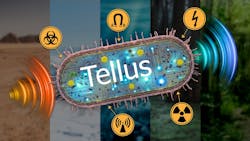Battelle joins Draper in project to develop microbe-based sensors to detect chemicals and explosives
ARLINGTON, Va. – U.S. military researchers needed the ability to use microbes to sense harmful agents like heavy metals, organic pollutants, explosives, chemical warfare agents, and poison gases for long-duration standoff applications. They found a solution from the Battelle Memorial Institute in Columbus, Ohio.
Officials of the U.S. Defense Advanced Research Projects Agency (DARPA) in Arlington, Va., announced a $10.7 million contract to Battelle on Wednesday for the Tellus program to design and build microbial sense-and-respond devices for environmental monitoring.
Battelle joins the Charles Stark Draper Laboratory Inc. in Cambridge, Mass., which won a Tellus contract earlier this month.
Battelle and Draper scientists will map-out the modular design of microbe-based sensors, and determine the environmental conditions in which these sensors can operate. The labs will determine options for biologically encoded information processing, types of output signals these sensors can generate, and stand-off distances at which they are effective.
DARPA especially is interested in chemical and physical stimuli, with emphasis on using sensors across many different environmental conditions for monitoring military threats, pollutants, or changing conditions.
Current approaches to environmental monitoring rely on distributed sensor nodes on the ground or in the water, as well as on remote sensing using satellites or unmanned systems. Improvements to existing microbial sensors could enable more rapid development of sensors for new threats; spatial resolution and confidence in sensor results; and help reduce power consumption and maintenance.
Microbial sense-and-respond devices could help detect analytes such as heavy metals, organic pollutants, energetic compounds, chemical warfare agents, and gases, with sensitivities comparable to conventional sensors.
Microbes are able to detect and discriminate between several chemicals of interest, as well as respond to ultraviolet to near-infrared light, electrical potential, low frequency ultrasound, magnetic fields, temperature changes, and RF and microwaves.
Related: Engineers uncover magic of microbes for biofuels, threat detection
Some environmental microbes are effective in corrosive or high-radiation conditions, and can use biologically encoded digital, analog, neural network processing. They also may be able to harvest energy to self-power.
Battelle and Draper Lab scientists will develop six unique microbial sense-and-respond devices that will function in a range of environments to enable an end user to specify the kind of stimuli to detect; preferred output signal; distinguish between different stimuli; and anticipated environmental conditions.
Battelle and Draper experts will focus on lowering limits-of-detection without increasing background; employing more sensitive receptors with small dynamic ranges that suffer from saturation at higher concentrations; use in realistic environmental conditions; receiver integration to collect and measure output signals; and determine whether to use single cells vs. several cells or consortia.
For more information contact Battelle Memorial Institute online at www.battelle.org, the Charles Stark Draper Laboratory at www.draper.com, or DARPA at www.darpa.mil.
About the Author
John Keller
Editor-in-Chief
John Keller is the Editor-in-Chief, Military & Aerospace Electronics Magazine--provides extensive coverage and analysis of enabling electronics and optoelectronic technologies in military, space and commercial aviation applications. John has been a member of the Military & Aerospace Electronics staff since 1989 and chief editor since 1995.
